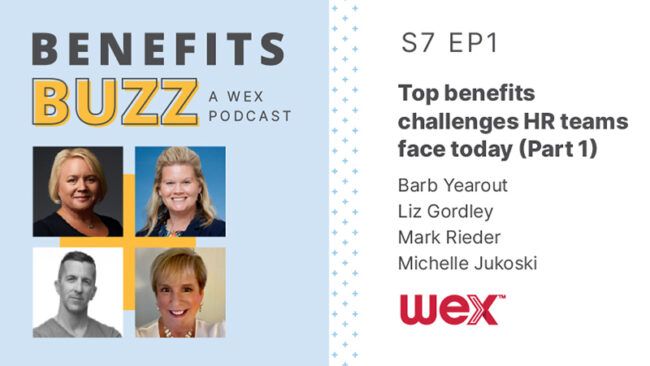Stay connected
Subscribe to our Inside WEX blog and follow us on social media for the insider view on everything WEX, from payments innovation to what it means to be a WEXer.
"*" indicates required fields

From the rising costs of healthcare and benefits packages to retaining and recruiting to helping employees understand their benefits to the ever-changing regulatory landscape, HR teams face many challenges that present obstacles to organizational success. Keep reading to learn more about the top three challenges HR teams face and watch our Season 7 opener of our Benefits Buzz podcast to discover our tips on overcoming these challenges.
Effective communication and engagement are crucial to caring for your employees. But what drives employees to seek care, and what barriers stand in their way? In our latest podcast episode, we delved into the motivators and demotivators influencing employees’ healthcare decisions to empower you with the tools you need to engage your employees.
One of the biggest obstacles mentioned is fear—fear of the unknown, fear of costs, fear of inconvenience. Many employees hesitate to seek medical care because of financial implications. They worry: How much will this cost me? Moreover, the inconvenience factor also plays a significant role. With busy schedules as working professionals, finding time for a doctor’s visit can seem like a luxury. But it’s not just fear and inconvenience at play; health and financial literacy also plays a role. Understanding medical jargon, navigating insurance plans, and deciphering benefits can be difficult for many.
So, what’s the solution? It’s all about benefits choice and customization. Recognizing the diverse needs of your workforce is paramount. After all, a one-size-fits-all approach simply won’t suffice in an age where multiple generations coexist in the workplace. However, balancing employee needs can prove to be complicated. Too many options can overwhelm employees, leading to decision paralysis and underutilization.
That’s where decision support tools come in. By providing personalized guidance, these tools empower employees to make informed choices aligned with their individual goals. For example, My HSA Planner makes learning about how to utilize health savings accounts (HSAs) a breeze. Additionally, AI tools can further streamline benefits information, making it easier for your employees to digest. Finally, continuous support is essential throughout the year to ensure employees understand and optimize their benefits.
Within HR teams, attracting and retaining talent is always a top priority. But what incentives resonate most with employees? Voluntary benefits have been trending, offering employees greater control over their benefits package. As we noted previously, choice is a significant driver for employee satisfaction. Another plan that has gained popularity in recent years is lifestyle spending accounts (LSAs). These accounts, funded by employers, provide employees with designated funds to spend on predetermined items, such as wellness programs or fitness memberships. Offering LSAs provides more options to your employees and shows them you want to invest in their well-being.
Employer contributions to HSAs can also serve as powerful incentives. Even modest contributions from employers can motivate employees to engage with their health benefits, driving participation and long-term savings for both employee and employer. By emphasizing the value of these offerings in supporting employees’ well-being and financial security, you can differentiate your offerings to attract and retain talent.
With the increase of healthcare costs, cost containment strategies are essential for employers to maintain financial sustainability while providing comprehensive benefits to employees. One effective strategy is shifting focus towards preventative care. By addressing health concerns early and promoting employee wellness initiatives, employers can mitigate the need for costly interventions down the line. Telemedicine solutions offer convenient alternatives to traditional healthcare delivery, reducing barriers to access and promoting early intervention.
Moreover, incentivizing employees to seek cost-effective care can yield savings for employers too. Tighter networks and incentive programs encouraging cost-sharing can also help reduce costs. Finally, ensuring accurate enrollment and eligibility is another potential strategy employers can utilize. Employers can avoid unnecessary expenses and optimize benefits utilization by verifying dependents’ eligibility and eliminating unnecessary coverage.
Make sure to check out our employee benefits engagement guide to gain even more insights into solving your pressing benefits challenges!
The information in this blog post is for educational purposes only. It is not legal or tax advice. For legal or tax advice, you should consult your own legal counsel, tax and investment advisers.
WEX receives compensation from some of the merchants identified in its blog posts. By linking to these products, WEX is not endorsing these products.
Subscribe to our Inside WEX blog and follow us on social media for the insider view on everything WEX, from payments innovation to what it means to be a WEXer.
"*" indicates required fields